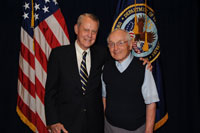Office of Research & Development |
 |


Thomas E. Starzl, MD, PhD, who was a VA transplant surgeon and research scientist for nearly 50 years, received the Lasker-DeBakey Clinical Medical Research Award for 2012 from the Albert and Mary Lasker Foundation.
Starzl, who retired from VA in 1998, shares the award with Roy Y. Caine of the University of Cambridge, in England. Both men were recognized for their development of liver transplantation, which has restored life to thousands of patients with end-stage liver disease.
Often called "the father of human transplantation," Starzl served in the Navy in World War II. He began his VA career in the 1950s in the Chicago VA Research Hospital (now part of the Jesse Brown VA Medical Center). As a surgeon at the hospital, and as a member of the Northwestern University faculty, Starzl become interested in helping patients with serious liver diseases to survive. In those years, these diseases were usually fatal.
Starzl soon moved to the University of Colorado and the Denver VA Medical Center. In 1962, he conducted the first long-term successful kidney transplant at the Denver VA, using the drug azathioprine and the steroid prednisone to keep the body from rejecting the new kidney. A number of his early kidney patients are still alive today, nearly 50 years after surgery (See sidebar, below). Before Dr. Starzl began transplanting kidneys, the longest a patient with such a transplant had survived was less than two years.
In 1963, Starzl attempted the first human liver transplant. The patient died during the operation. Several subsequent operations proved only that transplanted livers could function, but did not result in long-term success. Starzl worked to improve the procedure and began transplanting livers again in 1967. This time, he treated patients with three drugs, including an antibody, anti-lymphocyte globulin, which curbs rejection. Survival times began to exceed one year, and the world's longest-time survivor has now carried her transplanted liver for more than four decades. Starzl would follow up with further enhancements to the regimen in future years, such as the introduction in 1980 of cyclosporine, a new anti-rejection medication.
Starzl joined what is now the VA Pittsburgh Health Care System and the University of Pittsburgh School of Medicine in 1981. The university has named one of its medical research buildings and its transplantation program for him. At age 86, he remains active in research at the university, mapping the interaction between donor and recipient cells and developing new ways to further lessen the risk of organ rejection and prevent the harmful side effects of immunosuppressive therapy.
"Every successful transplant accomplished by VA surgeons, and by surgeons everywhere, is a tribute to [Starzl's] skill as a physician and a researcher," notes Joel Kupersmith, MD, chief research and development officer for VA. "His work has changed the way in which medicine is practiced forever."
The Lasker Awards are among the most respected science prizes in the world, given to visionary medical researchers whose work has helped prevent disease and prolong life. Starzl is VA's seventh Lasker Award recipient.